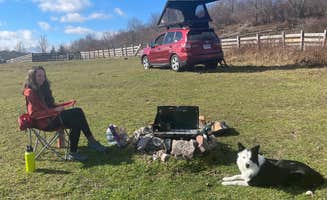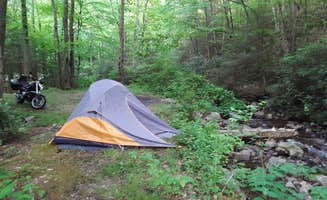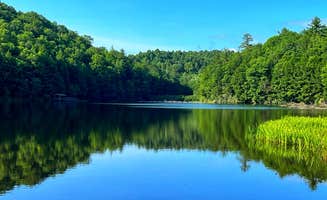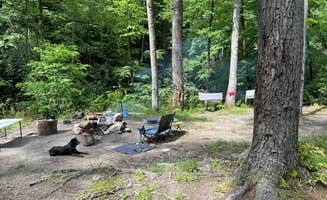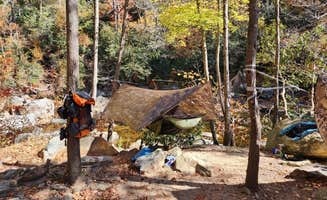Dispersed camping near Laurel Springs, North Carolina includes primitive sites with variable access requirements across nearby national forests. Roads leading to campsites often demand careful navigation, with Forest Road 197 requiring high-clearance vehicles during wet conditions. Summer temperatures typically range 70-85°F during day and 55-65°F at night, while winter camping requires preparation for freezing temperatures and potential snow accumulation.
What to do
Waterfall exploration: Steele Creek offers excellent swimming opportunities with natural pools and small cascades. "There's a walking trail at the end of the road about 100 feet from our site, that had the best swimming hole at the end of it, where you can jump in. It has a couple small waterfalls to add to the ambience," notes one camper at Steele Creek.
Wildlife viewing: Mount Rogers National Recreation Area features wild pony sightings in higher elevations. "Variety of types of campsites. Amazing sights and wild ponies! The AT provides some great hiking," says a visitor to Mount Rogers National Recreation Area.
Stargazing: Clear mountain skies provide exceptional night viewing opportunities. A camper at Mount Rogers describes: "The night sky was one of the most memorable moments from our trip. I've never seen so many stars! Also has quick access to running spring water for drinking and a quick wash up."
Creek fishing: Multiple waterways support trout fishing with proper licensing. At Linville Gorge Wilderness, one camper reports: "You may also be able to trout fish in Linville River if it's trout season and you're licensed. Speckled and Rainbow trout are beautiful in this area. Most fall within the 8-12 inch range."
What campers like
Above-the-clouds experiences: Higher elevation sites offer unique views during certain weather conditions. At Whitetop, a camper shares: "The next morning was still foggy. As we're getting ready to head out for the day, all of a sudden the sun came out and we were ABOVE THE CLOUDS. It was absolutely stunning."
Creek sounds for sleeping: Waterside sites provide natural white noise. "I stayed here two nights because it was so beautiful! It is a little close to the main road, as others have mentioned, but it was still removed enough for me to feel remote. The creek is loud and the trees offered privacy," reports a camper at Upper Creek, Pisgah National Forest.
Fire ring availability: Most dispersed sites feature established fire rings. At Washington & Jefferson National Forest, campers found: "Our site had a good fire ring, and was on the edge of a creek that we could filter water from with ease."
Appalachian Trail proximity: Many sites connect directly to the AT. A Mount Rogers visitor explains: "It's right on the AT, so there are lots of through hikers that you'll see stop in for a night. That also means that there's lots of great hiking options!"
What you should know
Road conditions vary significantly: Many sites require appropriate vehicles. At Scales Trailhead Basecamp, one visitor warns: "The road in is...."rocky". High clearance 4wd needed. Not ADV friendly, unless you're very adventurous."
Cell service limitations: Expect communication blackouts. A camper at Little Tumbling Creek states: "Absolutely no verizon service at the site." Similarly, Washington & Jefferson Forest dispersed sites report "absolutely no cell service at this camp, you have to go into town or hike a local mountain to get service up high."
Unpredictable weather patterns: Mountain weather can change rapidly. At Whitetop, one camper advises: "Only camp here if there's clear sky's. Even then, the wind is killer and probably never lets up."
Camping permits: Some areas require advance notification. At Linville Gorge Wilderness, a camper explains: "There are primitive sites along the foot trail (Linville Gorge Trail) but you still need to call to let the park ranger/main office know when you're planning to camp and provide how many people will be camping."
Tips for camping with families
Swimming holes: Locate creek-accessible sites with safer water features. At Upper Creek, a camper reports: "a two mile long gravel road that parallels with a beautiful river with a bunch of pull offs to camp or hangout at."
Avoid crowded weekends: Some areas become party spots on weekends. "Traffic wasn't bad through the week but weekend it was busy. The next site up had over 25 cars and they were partying pretty loud," warns a visitor at Upper Creek.
Site selection for privacy: Position matters for family comfort. One Linville Gorge Wilderness camper shares: "These are pretty decent sites. You just pull off the road, set up and enjoy the camping experience. We hiked down to the gorge and also enjoyed the dispersed camping available right along the riverside, which was pretty cool but... that hike back up is a DOOZY especially with a pack on."
Pack sufficient water: Most sites lack potable water sources. "There is no drinking water, picnic tables, or even pit toilet, so come prepared," notes a visitor to Little Stony Creek Road Dispersed Area.
Tips for RVers
Limited RV options: Most primitive sites accommodate tents only. At Steele Creek, a camper notes: "Maybe I missed this in the reviews, but all but 1 site were best for tents. I drove in to camp in my car and there was only 1 spot, which is by the creek crossing, and it was already taken."
Forest road accessibility: Some areas can accommodate smaller RVs. "Road wasn't too bad, only a spot or 2 on the switchback that were probably best for a 4 wheel drive vehicle, but I'm sure most cars would be fine," explains a Steele Creek visitor.
Size restrictions: Little Tumbling Creek offers "flat field area for camping on way. Several spots by creek for van or tent camping," making it suitable for smaller recreational vehicles.
Road navigation challenges: Consider turning radius on forest roads. A Washington & Jefferson National Forest camper warns: "The road is pretty well maintained other than a few spots that you have to crawl through on the corners specifically."


